Milk production potential of silage made from red clover/grass swards
Date published:
Background: Historically red clover was a common constituent of grass seed mixtures in Northern Ireland. It had a particular role in grassland that was conserved as hay, where it increased the crude protein component of the hay crop, and provided a grazing aftermath with a high clover content.
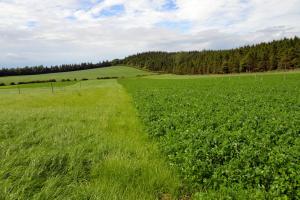
The introduction of nitrogen fertilizers and the change from hay making to silage production contributed to a decline in the importance of red clover within the local agricultural sector. However, the ability of red clover (a legume) to ‘fix’ atmospheric nitrogen, has resulted in renewed interest in its use in recent years. For example, research undertaken at AFBI Hillsborough demonstrated that a red clover crop could produce yields in excess of 13 t DM/hectare over a 4 year period, with zero inputs of fertiliser or manure nitrogen. As such, recent work at AFBI, Hillsborough, co-funded by DAERA and AgriSearch, examined the performance of dairy cows offered silages produced from grass only swards or grass/red clover swards.
The study
Three cuts of silage (harvests 1, 2 and 3) were harvested from either a pure grass sward, or a mixed grass/red clover sward, which had been sown the previous autumn. The grass sward received a total of 248 kg N/ha over the growing season, while no nitrogen was applied to the grass/red clover sward. These silages were then offered to mid-lactation dairy cows with all cows being offered 8.0 kg concentrate per day throughout the experiment.
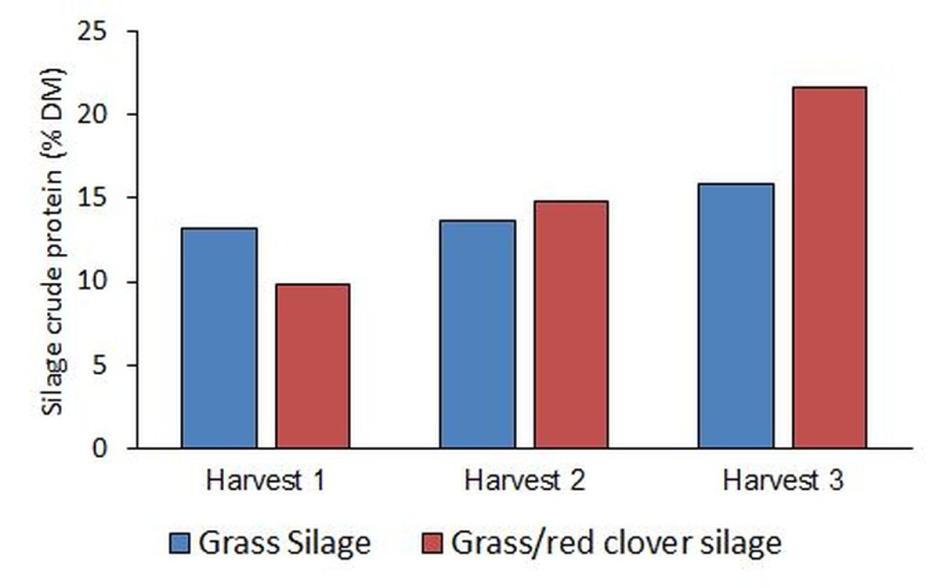
While the grass silage produced in each of harvests 1, 2 and 3 had a similar crude protein content (Figure 1), the crude protein content of the grass/red clover silage was very low at harvest 1 (9.8%, DM basis), moderate at harvest 2 (14.8%), and increased to 21.6% at harvest 3. This reflects the increasing proportion of red clover in the sward as the season progressed, estimated to be approximately 20% at harvest 1, 40% at harvest 2 and 60% at harvest 3. The metabolisable energy content of the silages produced were similar at each of harvests 1 and 2, but lower with the grass/red clover silage at harvest 3.
Silage DM intakes, milk yields and fat plus protein yields for the grass silage and grass/red clover silage at harvests 1, 2 and 3, are presented in Figure 2. These figures highlight the highly variable responses between harvests. For example, silage DM intakes were higher with the grass/red clover silages at harvests 1 and 2, but not at harvest 3. However, milk yield was unaffected by silage type at harvests 1 and 2, while being higher with the grass/red clover silage at harvest 3. Fat + protein yield was not affected by silage type at any harvest. However, when the mean performance across all three harvests is examined (Table 1) with the exception of silage DM intake, which was higher with the grass/red clover silage, none of the other measures differed between treatments.
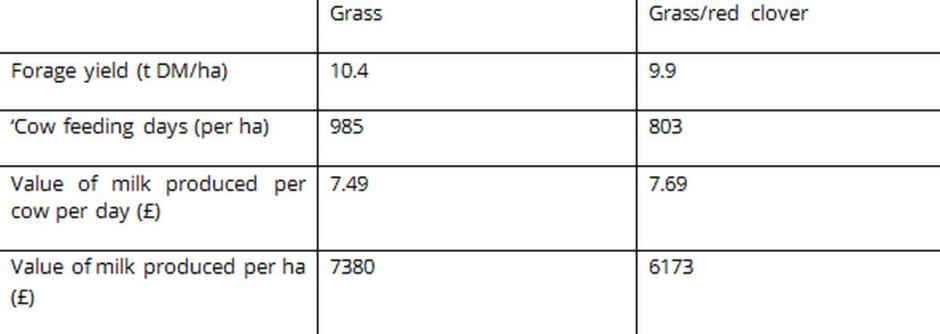
The study has clearly demonstrated the very different cow performance responses to red clover inclusion which can arise between individual harvests within a season, especially during the first full season following establishment, when the relative proportions of the two species changed considerably over the season. The variability in silage composition between harvests also creates very practical challenges. For example, the very different forage crude protein levels with the grass/red clover mix creates real practical difficulties in balancing the protein content of the diets offered.
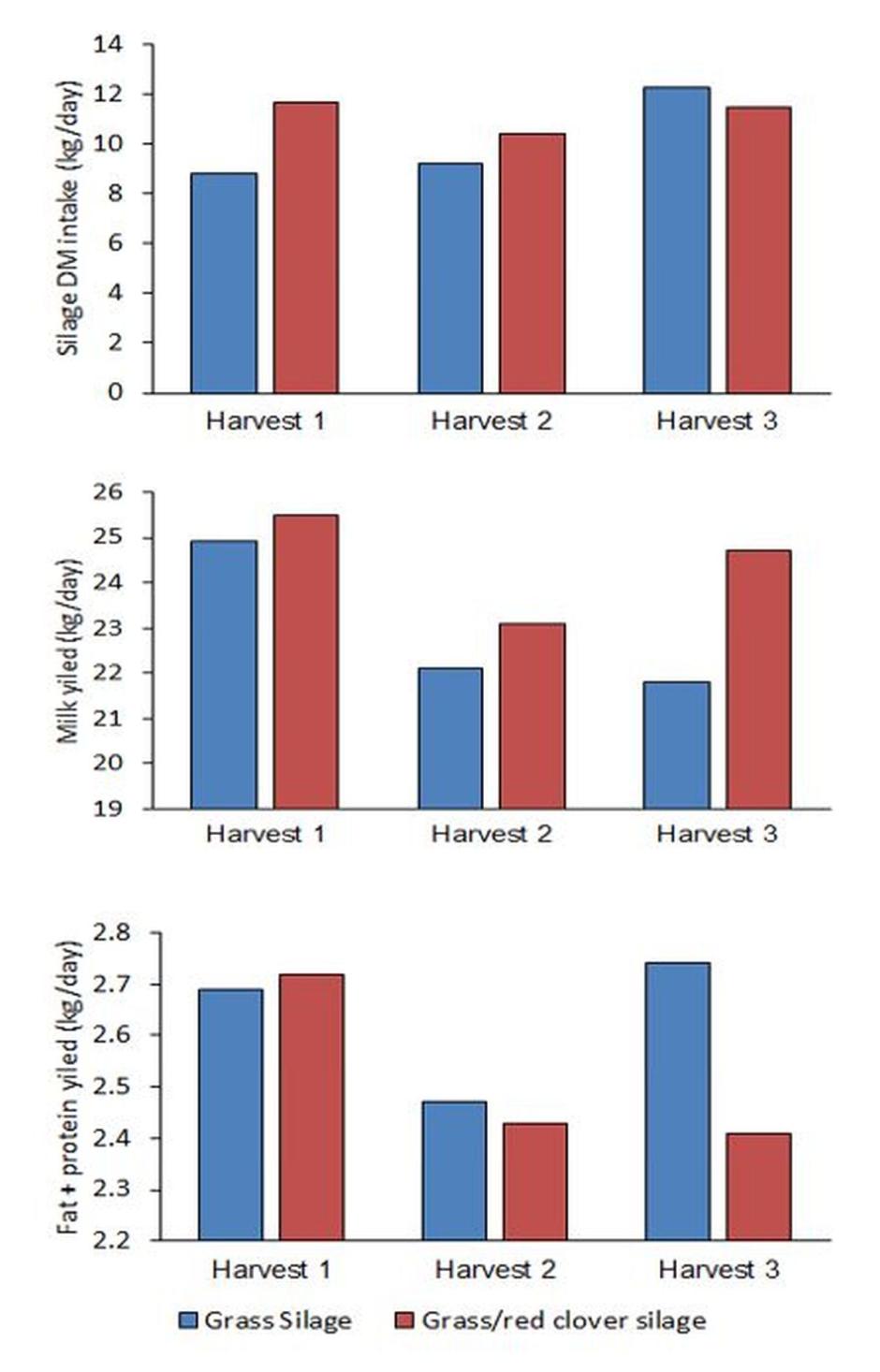
The total yield of DM over the three harvests was 10.4 t/ha with the grass sward and 9.9 t/ha with the grass/red clover sward (Table 2). Using these herbage yields (in-silo losses assumed as 10% of DM ensiled), and the mean silage intakes across the experimental period, one hectare of the grass sward was able to produce sufficient silage for 985 ‘cow feeding days’, while one hectare of the grass/red clover sward was able to provide sufficient silage for 803 ‘cow feeding days’ (Table 2).
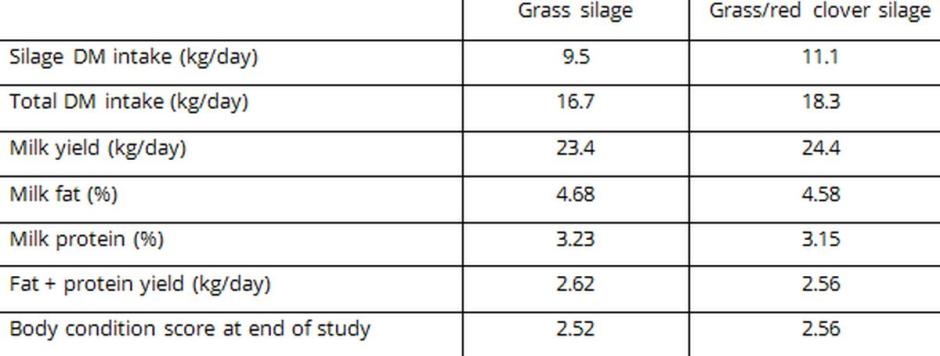
Given that the value of milk produced per cow/day was £7.49 with the grass silage and £7.69 with the grass/red clover silage (milk at 30 pence per litre) the total value of milk per hectare was £7380 and £6170 with the grass silage and grass/red clover silage, respectively. Thus, even considering the saving in fertiliser use with the grass/red clover silage system (approximately £750/ha), this did not compensate for the loss in the value of milk produced.
Furthermore, limits to red clover persistence also need to be taken into account, with reseeding of red clover swards normally required ever 3 – 4 years. In addition, the saving in fertiliser nitrogen creates another potential dilemma, in that red clover swards still have a requirement for phosphorus and potassium. Thus if these nutrients are to be supplied from slurry, the crop will likely be oversupplied in nitrogen, and the nitrogen fixing potential of the red clover will not be realised.
Conclusions
In this study, which involved a crop harvested in the first full season of growth following establishment, cow performance was extremely variable between harvests. However, the higher total DM intakes with the grass/red clover crop, combined with the lower yield of herbage grown, resulted in a lower value of milk produced per hectare with the grass/red clover silages.
This study was co-funded by DAERA and AgriSearch.
Notes to editors:
AFBI carries out high quality technology research and development, statutory, analytical, and diagnostic testing functions for DAERA and other Government departments, public bodies and commercial companies.AFBI's Vision is “Advancing the Local and Global Agri-Food Sectors Through Scientific Excellence”.AFBI's core areas:- Leading improvements in the agri food industry;- Protecting animal, plant and human health;- Enhancing the natural and marine environment.